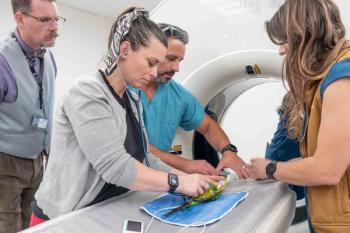
Ultrasonography of thorax CVC (Proceedings)
Radiographs are necessary prior to any US evaluation of the chest.
Radiographs are necessary prior to any US evaluation of the chest. As the air in the lung is an obstacle to propagation of the US beam, it is important to know where and what to look for.
The main indications for non-cardiac thoracic US are: assessment of thoracic wall swelling/mass, pleural effusion/thickening and underlying cause, suspected mediastinal or pulmonary mass, suspected lung lobe torsion, US guidance for fine-needle aspiration (FNA), biopsy or drainage.
If pleural effusion is present, ultrasonography is usually performed before drainage. However, if the patient shows respiratory compromise, therapeutic drainage is recommended.
The dog is positioned on lateral or sternal recumbency, depending on its clinical presentation. Patients with compromised breathing should be kept on sternal recumbency.
Occasionally, caudal thoracic lesions or the diaphragm can be evaluated via a transhepatic approach.
The soft tissues of the thoracic wall (skin, subcutaneous fat, muscles) appear as layered tissue immediately adjacent to the scan head. The parietal pleura may be differentiated from the visceral pleura in real time as the lung surface glides along it. The ribs appear as bright, smoothly marginated, curvilinear hyperechoic structures with distal sound beam attenuation. The lung interface is seen as a highly attenuating linear band deep to the thoracic wall. Distal to the echogenic lung interface, reverberation artifacts and “dirty shadowing” are noted, hampering evaluation of the deeper pulmonary parenchyma.
Cranial mediastinal vessels can be visualized as tubular anechoic structures.
THE THORACIC WALL
The main changes affecting the thoracic wall involve the ribs or sternum (fracture/osteomyelitis/tumor/deformity), and/or subcutaneous tissue (emphysema/cellulitis/abscess/ granuloma/tumor).
Ultrasound provides useful information about the internal architecture, size and extent of the lesion. Unlike radiographs, US allows easy differentiation between pleural effusion and thoracic wall lesion.
It allows the assessment of bone involvement, echotexture (solid vs. fluid-filled), margination, invasion of other structures, or presence of foreign material or gas (e.g., in abscesses associated with draining tract).
A thoracic wall mass lesion will commonly have a convexity that displaces the normal pleura-lung interface away from the transducer.
THE PLEURA AND THE PLEURAL SPACE
The main causes of pleural effusion are: congestive heart failure, chylothorax, pyothorax, trauma, pneumonia, bleeding disorder, toxic ingestion, tumor, hypoproteinemia, diaphragmatic hernia.
Ultrasonography may be used to identify small volumes of pleural fluid not detected radiographically, and to guide thoracocentesis. It may also reveal the source of the effusion by identifying an underlying lesion, such as a mass. Pleural effusion appears as echogenic or anechoic material within the pleural space, between the thoracic wall or diaphragm and visceral pleura/lung. The changes may be uni- or bilateral, symmetric or asymmetric. While transudates, modified transudates and chylous effusion generally are hypoechoic or anechoic, exudates, carcinomatosis or hemorrhage are more echogenic.
In cases of chronic effusion, echogenic fibrin strands may be seen floating within the fluid. The pleural surface can be assessed for integrity (e.g. after thoracic trauma), thickening and irregularity (such as seen in cases of severe pleuritis or diffuse neoplasia, e.g., carcinomatosis).
Real time ultrasound is useful in distinguishing pleural masses from pulmonary masses, which might be a challenging diagnosis radiographically. While a pulmonary mass moves with respiration, a mass arising from the parietal pleura remains stationary in comparison to the moving lung. Additionally, the detection of smaller pleural nodules and masses on radiographs is commonly hampered by the presence of pleural effusion. Focal pleural lesions include mesothelioma and pleural metastatic neoplasia.
Free air within the pleural space-pneumothorax creates the same reverberation artifacts as does the normal lung; however, the classical “gliding sign” of the lung against the parietal pleura is not observed. In cases of concurrent pleural effusion, a gas-fluid interface may be visualized.
THE MEDIASTINUM
The mediastinum is best evaluated using radiographs and/or CT. Ultrasound facilitates differentiation of several entities causing cranial mediastinal widening on radiographs such as accumulation of fat, fluid, or mediastinal masses. Additionally, as cranial mediastinal masses are commonly accompanied by pleural effusion, they are often masked on thoracic radiographs.
If moderate bilateral pleural effusion is present, it can help to better outline the mediastinal structures. Mediastinal masses are commonly located cranial to the heart, and are often accompanied by pleural effusion. Their visualization depends on their location and size, and on the ability to use pleural fluid or consolidated lung as an acoustic window. Differential diagnoses for cranial mediastinal mass lesions include neoplasia such as lymphoma, thymoma, metastatic disease, inflammatory processes (abscesses, granulomas), cysts, and hemorrhage/hematoma.
Idiopathic cranial mediastinal cysts (occasionally seen in cats) are usually thin-walled and filled with anechoic fluid.
THE LUNGS
Survey radiographs are very helpful in assessing pulmonary parenchyma. It is a fast, cost effective method to provide a global two-dimensional view of the thorax. However, at times, the distribution and appearance of the pulmonary changes are non-specific. When the changes are superficial, US may be proven useful in differentiating fluid from soft tissue, and in assessing the shape of a lung lobe. A triangular lung lobe with flat margins is often seen in consolidation (hemorrhage, pneumonia, torsion), a triangular lung lobe with concave margins is encountered in atelectasis, while a rounded nodule or mass is more commonly seen in tumors or abscess. The echogenicity of the lesion (i.e., uniform versus fluid pockets) can also assist in defining better the lesion(s
Pulmonary consolidation occurs when fluid or cells infiltrate the pulmonary air spaces, with preserved lung volume. If still air-filled, bronchi appear as hyperechoic “air bronchograms” radiating from the hilus. Residual air within alveoli and bronchi creates multiple echogenic foci, commonly with distal reverberation or shadowing artifacts. If the lumen of the bronchus also becomes filled with secretions or cellular debris, “fluid bronchograms” develop, which resemble vessels.
Atelectasis (pulmonary collapse) may occur passively secondary to pneumothorax or pleural effusion or primary, when the bronchus is obstructed by a mucus plug or a mass, or subsequent to lung lobe torsion. Affected lung lobes appear as small triangular (concave margins), highly echogenic structures floating within pleural fluid, attached to the principal bronchi. In cases of obstructive atelectasis, ultrasonography may assist in identification of the obstructive lesion (e.g., mass).
Acute lung lobe torsion can sometimes be differentiated from other causes of pulmonary collapse, when the displaced tip of the affected lobe is outlined by pleural effusion.
Like all thoracic lesions, pulmonary masses can be examined only sonographically, if they are located in the periphery of the lung. Pulmonary neoplasms usually appear hypoechoic, solid,
and cause focal disruption of the reflective lung surface. They usually move with the rest of the lung during respiration; however, this feature is not observed in cases of invasion of the thoracic wall or pleural adhesion. Central necrosis of a tumor appears as a hypoechoic or anechoic center, which may mimic the appearance of pulmonary abscess.
DIAPHRAGMATIC HERNIAS
In traumatic hernias, US can be used to assess the cranial abdomen and confirm cranial displacement of abdominal organs such as liver, gallbladder, spleen, stomach/small bowel. However, if only a small amount of falciform or omental fat is displaced in the chest, US may not be the best reliable procedure as so many artifacts are present near the diaphragm (mirror image, diffraction). Positional radiographs or positive contrast examination (coeliography) may complement the evaluation.
Similarly, ultrasound can be used in the identification of true (congenital) diaphragmatic hernias and congenital peritoneo-pericardial diaphragmatic hernias (PPDH).
INTERVENTIONAL PROCEDURES:
As long as a lesion is clearly delineated and safely reachable, US-guided biopsy or fine needle aspirate is a safe method to sample the lesion wherever its location is. Color flow assessment is more challenging in the thorax as breathing motion greatly affect the quality of the signal.
Newsletter
From exam room tips to practice management insights, get trusted veterinary news delivered straight to your inbox—subscribe to dvm360.






